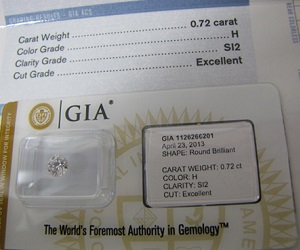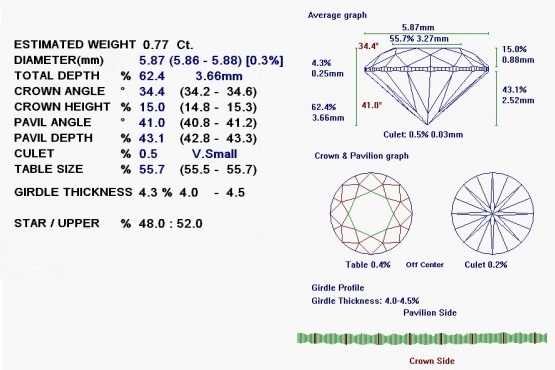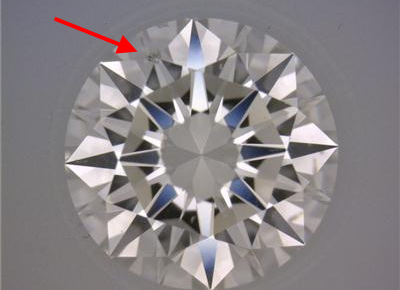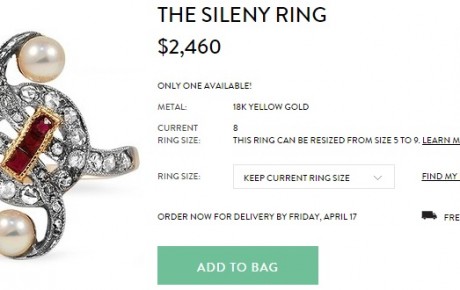When Would a Sarin Report Be Useful For a Consumer?

GIA introduced new versions of grading reports in 2006.
In early 2006, GIA made a series of changes to the format of their grading report. They started to assign cut grades for round brilliant diamonds and included data on cut proportions (crown angles, pavilion angles and etc) in their reports. This revamp in GIA’s grading report format subsequently caused huge changes to the role a Sarin report has in the market.
Now, you might be wondering what’s the difference between a lab report and a Sarin report? In a nutshell, the GIA certificate contains averaged measurements of a diamond’s proportions instead of individual measurements found in a Sarin report.
For example, instead of showing 8 separate values for crown angles, the GIA report shows an averaged number for these readings. Likewise, this applies to other measurements like the girdle thickness, pavilion angles and etc… The great thing about the revamped report style is that it contains critical data for consumers without being too overwhelming.
Still, there are some situations where it is better for you obtain a copy of a Sarin report. One such scenario happens when you intend to purchase a diamond graded before 2006 ( e.g. an estate diamond ring).
It is advisable for you to get a Sarin scan performed so that you have the necessary cut proportions for analysis. However, my best recommendation for dealing with such purchases is to get the stone sent to GIA for a re-grading.
Why Would You Still Need a Sarin Report?

Careful…
Question: If diamond proportions had already been included in a grading report, why is there a need for a Sarin scan of the diamond?
Answer: In my experience of looking at diamonds and verifying lab reports, I had personally found discrepancies in cut ratings and measurements issued by labs like EGL.
As a precautionary measure, it is wise to request a Sarin scan if you are buying non-GIA/AGS diamonds. You basically want to have this additional information to back up the cut details that are listed on the report.
Note: I only recommend AGS and GIA as they are the most reliable labs in the world.
Typically, proportions and angles provided in AGS reports have been found to be spot on and precise. On the other hand, GIA applies a slightly different methodology when displaying their measurements.
Due to the rounding and averaging of numbers, you might see variances when you compare their results to that of an actual Sarin scan.
Sarin Can Tell You How Precisely a Diamond is Cut
Since the GIA reports only show averaged measurements, there will be subtle differences in cut properties between 2 diamonds even if they have similar specifications on their GIA certificate. These minor differences can sometimes account for a significant price difference (money!) and that’s where a Sarin report would be useful.
For example, a Sarin scan would not only reveal the overall relationships between different facets, it would also provide in-depth details of how each facet meet at their points. Here are 2 examples of Sarin reports that were generated for 2 round brilliant cut diamonds:


Based on the 2 reports above, which diamond do you think is cut to better precision? If you guessed the first stone, you are right. Smaller tolerances shown in the first diamond is evidence that the cutter took greater care in creating proper facet alignments.
On the corresponding GIA report for the first diamond, the crown angles are rounded up to the nearest 0.5° and simply shown as 34.0°. Likewise for the second diamond, the crown angle is reported simply as 34.5° on the GIA report.
With an average of 8 measurements and subjecting the final number to rounding, a 34.0° crown measurement could mean a lot of things. Now, do you understand why there are certain limitations to a GIA grading report?
Precision Cutting May Not Always Equate to the Best Optics
Although it is generally true that a diamond has better brilliance when it is cut to better precision, there are times where having precision doesn’t necessarily translate to having better optics.
The light performance of a diamond is largely influenced by proportions. For example, even if a diamond has very tight tolerances of less than 0.1° for all 8 of its pavilion angles, it wouldn’t matter if the facets are cut to a steep 45.0°. Being precisely cut with bad proportions will still result in a dull and lifeless looking diamond.
To conclude, a Sarin report is a useful tool for people who want to assess a diamond analytically since it can show you minute details. However, if you don’t want to deal with a string of confusing numbers, getting an Idealscope/ASET image is the easier way for you to perform critical cut evaluation without getting too technical.
<< Prev PageRelated Articles
Leave A Comment














6 Comments
I have requested Sarin reports on an AGS diamond from an online vendor. However, there is some slight deviation in the angles measured by the vendor’s Sarin and that found in the AGS light performance report.
Who is right in this case?
Hi,
I would expect only minor differences between the angles and proportions measured. Calibration of individual machines is the key to maintaining accurate results. Sometimes, poor maintenance and usage practices might cause readings to become off.
Unless you see gross differences of more than 0.2% for proportions or deviations of more than 0.2 degrees for angles, there’s really no cause for concern. If you see significant deviations, call the vendor up and ask him why.
Paul
what is difference between sarin dia-scan and dia-mension? Are both machines camera based? Is there any other technology difference between the two?
Both machines are camera based. The dia-scan is a portable system. In terms of accuracy, the dia-scan is relatively less accurate compared to the dia-mension. The technical specifications are as follow in terms of accuracy: linear: ±20 microns (± 0.02 mm) , angular: ±0.2 degree. Also, you will need different models of the dia-scan to scan diamonds of different sizes. For the dia-mension, it is a one-size fits all. It comes with interchangeable lens for different diamond sizes.
I have a 1.71 ct EC loose diamond with a recent GIA report. I contacted GIA and provided them the GIA report # and asked if a Sarin report exists for the gem. They informed me that no Sarin report exists. How can I obtain a Sarin report for my diamond?
GIA does not offer Sarin reports to consumers. They are a gemological laboratory and only offers grading reports. If you need one, you will need the retailer to do a scan of the diamond with their Sarine machine. Alternatively, you can get an appraiser with this scanning equipment to get the information you require.